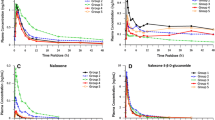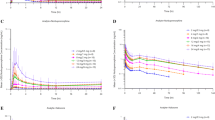Abstract
Naloxegol is a peripherally acting µ-opioid receptor antagonist approved for use as an orally administered tablet (therapeutic doses of 12.5 and 25 mg) for the treatment of opioid-induced constipation. Over a wide dose range (i.e. single supratherapeutic doses up to 1000 mg in healthy volunteers), the pharmacokinetic properties of naloxegol appear to be time- and dose-independent. Naloxegol is rapidly absorbed, with mean time to maximum plasma concentration of <2 h. Following once-daily administration, steady state is achieved within 2–3 days and minimal accumulation is observed. The primary route of naloxegol elimination is via hepatic metabolism, with renal excretion playing a minimal role. In clinical studies, six metabolites were found in feces, urine or plasma, none of which have been identified as unique or disproportionate human metabolites. The major plasma circulating species is naloxegol. There are small effects of mild and moderate renal impairment, age, race, and body mass index on the systemic exposure of naloxegol; however, gender has no effect on the pharmacokinetics of this agent. Naloxegol is a sensitive substrate of cytochrome P450 (CYP) 3A4 and its exposure can be significantly altered by strong or moderate CYP3A modulators. Food increases the bioavailability of naloxegol, and the relative bioavailability of the tablet formulation was not limited by dissolution. Naloxegol in the dose range of 8–125 mg can antagonize morphine-induced peripheral effects without impacting the effect of morphine on the central nervous system, consistent with a peripheral mode of action.







Similar content being viewed by others
References
World Health Organization. WHO’s pain ladder. 1996. Available at: http://www.who.int/cancer/palliative/painladder/en/. Accessed 16 July 2016.
Chou R, Fanciullo GJ, Fine PG, et al. Clinical guidelines for the use of chronic opioid therapy in chronic noncancer pain. J Pain. 2009;10(2):113–30.
Pappagallo M. Incidence, prevalence and management of opioid bowel dysfunction. Am J Surg. 2001;182:11s–8s.
Panchal SJ, Muller-Schwefe P, Wurzelmann JI. Opioid-induced bowel dysfunction: prevalence, pathophysiology and burden. Int J Clin Pract. 2007;61(7):1181–7.
Camilleri M. Opioid-induced constipation: challenges and therapeutic opportunities. Am J Gastroenterol. 2011;106:835–42.
American Society of Pain Educators. Pocket guide: opioid induced constipation. International Guidelines Center; 2010.
Sobczak M, Sałaga M, Storr MA, Fichna J. Physiology, signaling, and pharmacology of opioid receptors and their ligands in the gastrointestinal tract: current concepts and future perspectives. J Gastroenterol. 2014;49(1):24–45.
Bell TJ, Panchal SJ, Miaskowski C, et al. The prevalence, severity, and impact of opioid-induced bowel dysfunction: results of a US and European Patient Survey (PROBE 1). Pain Med. 2009;10(1):35–42.
Drewes AM, Munkholm P, Simrén M, et al. Definition, diagnosis and treatment strategies for opioid-induced bowel dysfunction: recommendations of the Nordic Working Group. Scand J Pain. 2016;11:111–22.
Coyne KS, LoCasale RJ, Datto CJ, et al. Opioid-induced constipation in patients with chronic noncancer pain in the USA, Canada, Germany, and the UK: descriptive analysis of baseline patient-reported outcomes and retrospective chart review. Clinicoecon Outcomes Res. 2014;6:269–81.
Christensen HN, Olsson U, From J, Breivik H. Opioid-induced constipation, use of laxatives, and health-related quality of life. Scand J Pain. 2016;11:104–10.
Movantik™ (naloxegol): full prescribing information. Wilmington, DE: AstraZeneca Pharmaceuticals LP; 2015.
Moventig® (naloxegol): full prescribing information. Södertälje: AstraZeneca AB; 2014.
Tack J, Cimen A, Bui K, Sostek M. Naloxegol for opioid-induced constipation: mechanism of action and clinical implications [abstract]. United Eur Gastroenterol J. 2015;3(5 Suppl):A20.
Bui K, Birmingham B, Ulysses Diva U, Berger B. An open-label, randomized, bioavailability study of alternative methods of oral administration of naloxegol in healthy subjects. Clin Pharmacol Drug Dev. 2016 (accepted).
Data on file. Wilmington. DE: AstraZeneca; 2011.
Eldon MA, Song D, Neumann TA, Wolff R, Cheng L, Viegas TX, et al. NKTR-118 (oral PEG-naloxol), a PEGylated derivative of naloxone: demonstration of selective peripheral opioid antagonism after oral administration in preclinical models. American Academy of Pain Management 18thAnnual Clinical Meeting; 27–30 Sep 2007; Las Vegas, NV.
Faassen F, Vogel G, Spanings H, Vromans H. Caco-2 permeability, P-glycoprotein transport ratios and brain penetration of heterocyclic drugs. Int J Pharm. 2003;263:113–22.
Al-Huniti N, Chapel S, Xu H, Bui KH, Sostek M. Population pharmacokinetics of naloxegol in a population of 1247 healthy subjects and patients. Br J Clin Pharmacol. 2016;81:89–100.
Bui K, She F, Sostek M. The effects of mild or moderate hepatic impairment on the pharmacokinetics, safety, and tolerability of naloxegol. J Clin Pharmacol. 2014;54(12):1368–74.
Bui K, She F, Zhou D, Butler K, Al-Huniti N, Sostek M. The effect of quinidine, a strong P-glycoprotein inhibitor, on the pharmacokinetics and central nervous system distribution of naloxegol. J Clin Pharmacol. 2015;56(4):497–505.
Bui K, She F, Hutchison M, Brunnström Å, Sostek M. Absorption, distribution, metabolism and excretion of [14C]-labeled naloxegol in healthy subjects. Int J Clin Pharmacol Ther. 2015;53:838–46.
Eldon MA, Kugler AR, Medve RA, et al. Safety, tolerability, pharmacokinetics, and pharmacodynamic effects of naloxegol at peripheral and central nervous system receptors in healthy male subjects: a single ascending-dose study. Clin Pharmacol Drug Dev. 2015;4(6):434–41.
Eldon MA, Kugler AR, Medve RA, et al. Safety, tolerability, and pharmacokinetics of multiple ascending doses of naloxegol. Clin Pharmacol Drug Dev. 2015;4(6):442–8.
Webster L, Dhar S, Eldon M, Masuoka L, Lappalainen J, Sostek M. A phase 2, double-blind, randomized, placebo-controlled, dose-escalation study to evaluate the efficacy, safety, and tolerability of naloxegol in patients with opioid-induced constipation. Pain. 2013;154(9):1542–50.
Data on file. Wilmington. DE: AstraZeneca; 2013.
Bui K, She F, Sostek M. The effects of renal impairment on the pharmacokinetics, safety, and tolerability of naloxegol. J Clin Pharmacol. 2014;54:1375–82.
Nolin TD, Naud J, Leblond FA, Pichette V. Emerging evidence of the impact of kidney disease on drug metabolism and transport. Clin Pharmacol Ther. 2008;83:898–903.
Bui K, Zhou D, Sostek M, She F, Al-Huniti N. Effects of CYP3A modulators on the pharmacokinetics of naloxegol. J Clin Pharmacol. 2016;56(8):1019–27.
Zhou D, Bui K, Sostek M, Al-Huniti N. Simulation and prediction of the drug-drug interaction potential of naloxegol by physiologically based pharmacokinetic modeling. CPT Pharmacomet Syst Pharmacol. 2016;5(5):250–7.
US Department of Health and Human Services, US Food and Drug Administration, Center for Drug Evaluation and Research. Guidance for industry: drug interaction studies—study design, data analysis, implications for dosing, and labeling recommendations. Draft guidance. February 2012. Available at: http://www.fda.gov/ucm/groups/fdagov-public/@fdagov-drugs-gen/documents/document/ucm070244.pdf. Accessed 8 Jun 2016.
Chey WD, Webster L, Sostek M, Lappalainen J, Barker PN, Tack J. Naloxegol for opioid-induced constipation in patients with noncancer pain. N Engl J Med. 2014;370(25):2387–96.
Al-Huniti N, Nielsen JC, Hutmacher MM, Lappalainen J, Cantagallo K, Sostek M. Population exposure-response modeling of naloxegol in patients with non-cancer-related pain and opioid-induced constipation. CPT Pharmacomet Syst Pharmacol. 2016;5(7):359–66.
Gottfridsson C, Carlson G, Lappalainen J, Sostek M. Evaluation of the effect of naloxegol on cardiac repolarization: a randomized, placebo- and positive-controlled crossover thorough QT/QTc study in healthy volunteers. Clin Ther. 2013;35(12):1876–83.
Webster L, Chey WD, Tack J, Lappalainen J, Diva U, Sostek M. Randomised clinical trial: the long-term safety and tolerability of naloxegol in patients with pain and opioid-induced constipation. Aliment Pharmacol Ther. 2014;40(7):771–9.
Author information
Authors and Affiliations
Corresponding author
Ethics declarations
Conflict of interest
Diansong Zhou, Hongmei Xu, and Nidal Al-Huniti are employees of AstraZeneca Pharmaceuticals LP; Eike Floettmann is an employee AstraZeneca UK Ltd; and Khanh Bui is a contractor for AstraZeneca Pharmaceuticals. Khanh Bui, Diansong Zhou, Hongmei Xu, Eike Floettmann and Nidal Al-Huniti own stock/stock options in AstraZeneca.
Rights and permissions
About this article
Cite this article
Bui, K., Zhou, D., Xu, H. et al. Clinical Pharmacokinetics and Pharmacodynamics of Naloxegol, a Peripherally Acting µ-Opioid Receptor Antagonist. Clin Pharmacokinet 56, 573–582 (2017). https://doi.org/10.1007/s40262-016-0479-z
Published:
Issue Date:
DOI: https://doi.org/10.1007/s40262-016-0479-z




